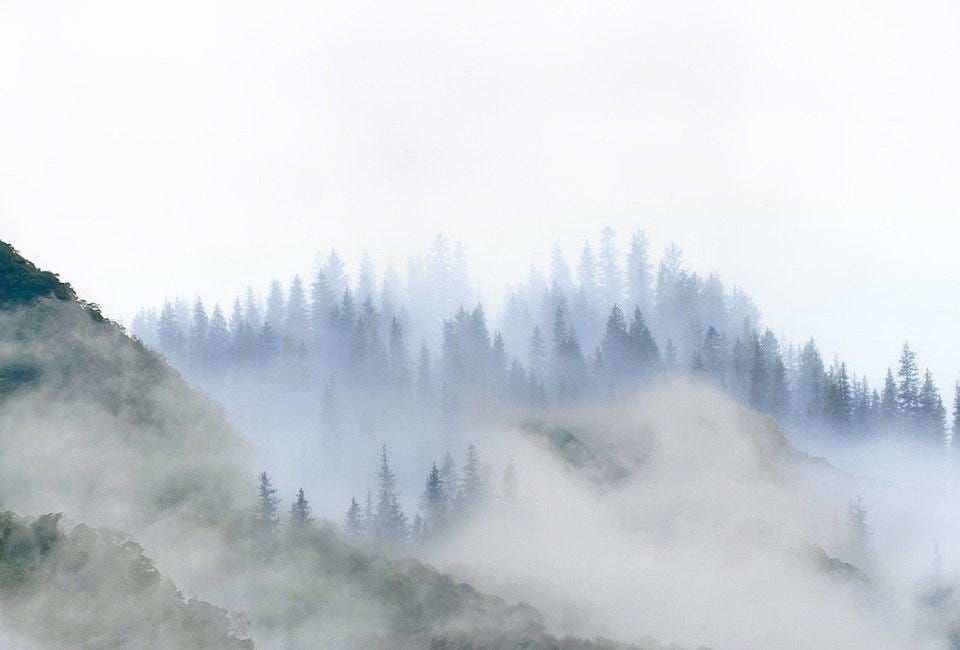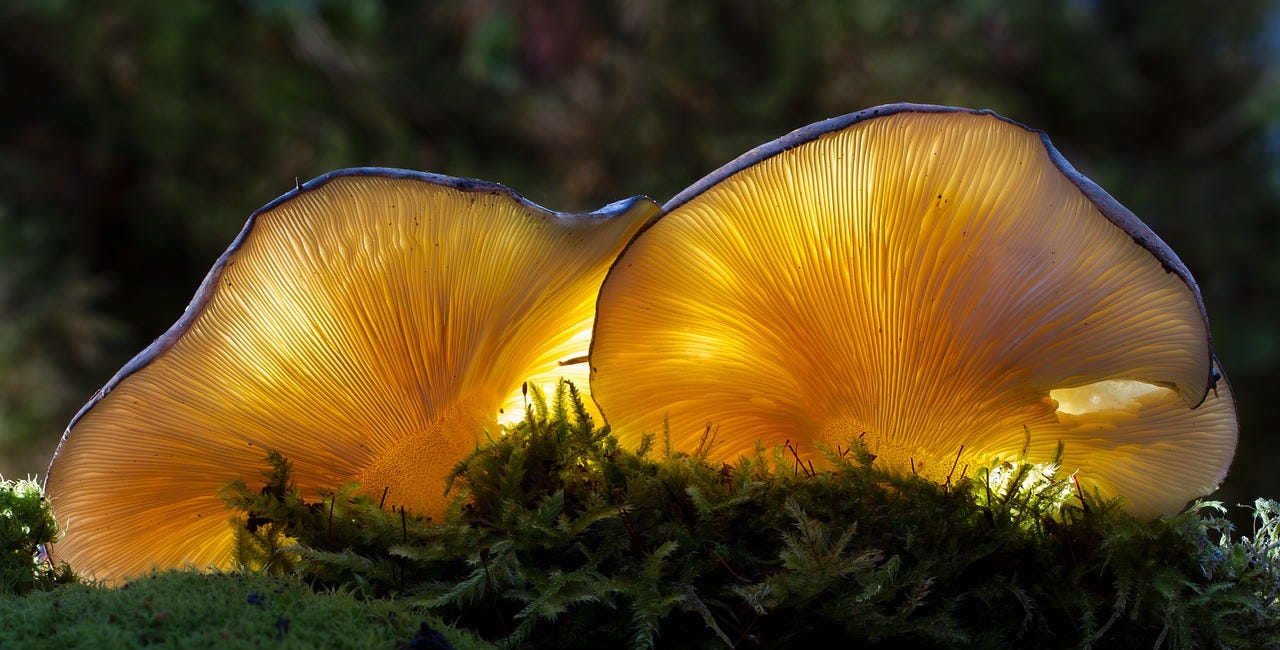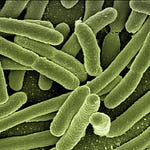Part 1: I See Something!
And if a man prevail against one, two shall withstand him: a threefold cord is not easily broken.
-Ecclesiastes 4:12, Douay-Rheims
Next stop on our Kingdom Grand Tour are two more rather mysterious realms. How can they not be when so many of their residents are invisible to us? When they have names like dog vomit slime mold and bleeding tooth mushrooms? When they look like plants (or maybe bacteria), and, yet, they’re not. These two mysterious realms are the Kingdom of the Protists and the Kingdom of Fungi. Fortunately, unlike the two tiny Kingdoms of Archaea and Bacteria, we can see many of these creatures if we search the woods and fields (and forgotten corners of refrigerators and pantries).
The most mystifying realm of them all is the Kingdom of the Protists. No joke: even scientists don’t really understand what is going on with these guys. Here’s how you can tell what is a protist: if something is not an animal, plant, fungus, bacteria, or archaea, then it is a protist. That’s like grouping together chocolate chip cookies, a hamburger, and iced tea because they are not Italian, Mexican, or Chinese food. Do you think those foods have much in common (besides being a pretty sweet lunch)? Not really, but if the only other option is “Other Foods,” then they would have to be grouped together. Same with the protists, its the “None of the Above” group of creation, but that just makes it all the more exciting to explore.
Flying over the Kingdom of the Protists, you would see much empty-looking soil and water, home to many thriving protists. You would also see oceans filled with towering green spires and fallen logs that are covered with disturbingly bright-colored goop.
Who would you like to visit first? Perhaps, I could interest you in the plant-like giant kelp forests that provide a home for many ocean creatures. If you are looking for something smaller, might I suggest the more animal-like amoebas, hunters of the microscopic world that can shift and transform their shape to envelope their prey. Looking for something a little bigger? Then step right on over to this deep-sea dwelling creature (a xenophyphorea, if you are brave); it has only one cell but is as large as a cereal bowl! If you are looking to stay a little more in your comfort zone, I highly recommend my favorite protist, the slime mold. These fluorescent yellow creatures seep an ooze over fallen trees and have even been known to solve mazes in their quest for food.
Once you are done exploring the epically bizarre Kingdom of the Protists, hop aboard your bird of choice and fly on over to the more familiar territory of the Kingdom of Fungi. As you fly overhead, you will see fallen logs, tree stumps, old apples, dried leaves, and all manner of dead things, each covered with gray or green fuzziness or perhaps some brightly colored mushrooms, with even more residents teeming around invisibly. What is up with all that dead stuff, you ask? You like tasty treats, don’t you? Oh, you don’t think stale bread sounds good? Fair enough, but one man’s trash is another fungi’s treasure. Fungi are one of the chief decomposers in many environments, breaking down dead creatures so that new creatures can take their place.
Now, I would bet that some of you think that fungi and mushrooms are the same thing. I can understand the confusion, after all mushrooms are the most charismatic of all fungi (the real fun guy in the group, you might say), but only about a sixth of the 75,000 known species of fungi have mushrooms.
Mushrooms come in an astonishing variety. Many mushrooms look like the typical white miniature umbrellas, but others are like shelves climbing up trees or tiny branches reaching for the sky or balls that explode in a cloud of dust when you touch them. They can be yellow, red, or orange and have evocative names like chicken of the woods or cauliflower mushrooms or lion’s mane. Many species of mushrooms are grown for us to eat, but others are extremely dangerous, so never eat a mushroom that you find – mushrooms are as beautiful and diverse as they can be dangerous.
In the Kingdom of the Fungi, there are also several types of creatures that are just one cell – yeasts, molds, and mildews. Yeasts have been our great help in the kitchen from the dawn of history, making breads light and fluffy, cheese blue and stinky, and the savory British spread Marmite...salty. Molds and mildews are decidedly less appetizing, such as when they are making fuzzy blue, red, or white colonies on our old bread or fruit.
Before we leave these two kingdoms, we must visit a creature that is neither here nor there, so to speak. It is a nomad that roams among the kingdoms: the lichen. Lichens grow on trees or rocks, looking kind of like flat leaves or short green branches or even orange dust. These creatures are made up of a fungus and a bacteria or an algae (a kind of protist) living together as one creature. The two working together are stronger than each on its own, allowing them to live in harsh environments like the Arctic or deserts. The protist or bacteria make food for the fungus, and the fungus provides water and protection. These little creatures are surely a wonder of creation.
Ready for More?
For Older Students:
Chapter 4B: The Kingdoms of the Protists and Fungi
Part 2: These are Fun Guys: Fungi and Fungus-Like Protists
For Younger Students:
Chapter 5: The Kingdom of Plants
Welcome to the first installment in the Kingdoms of Creation home education science program. We’re glad you’re here. Each chapter is split into two parts: Part 1 is for younger students (usually K-4); Parts 1 and 2 together are for older students (usually 5-8). The Kingdoms of Creation is a comprehensive biology program. See the full table of contents
Need Something Else?
Visit the Welcome Page
Welcome to the Kingdoms of Creation
A long time ago in land not so far away, the Creator made a world. This world was big and beautiful, wild and wonderful, fantastic and frightening. It was full of amazing creatures like the ping-pong tree sponge (an immobile creature that looks just like its name sounds but eats shrimp in the deep dark of the sea) and the dragon mantis (a large brown …
Or Check Out the Original Post
Chapter 4: The Kingdoms of the Protists and Fungi
Welcome to the first installment in the Kingdoms of Creation home education science program. We’re glad you’re here. Each chapter is split into two parts: Part 1 is for younger students (usually K-4); Parts 1 and 2 together are for older students (usually 5-8). The Kingdoms of Creation is a comprehensive biology program. See the full table of contents

















Share this post